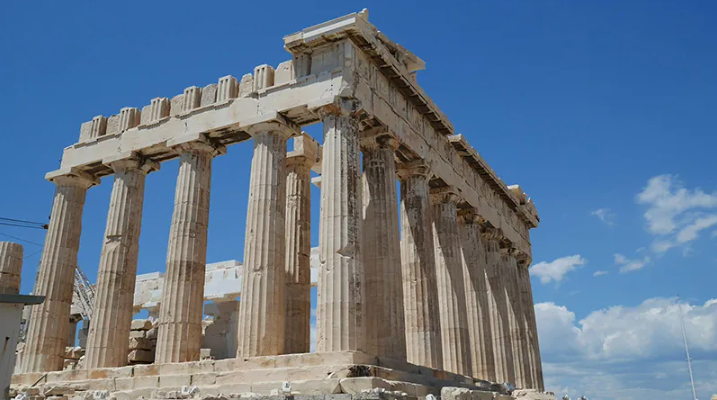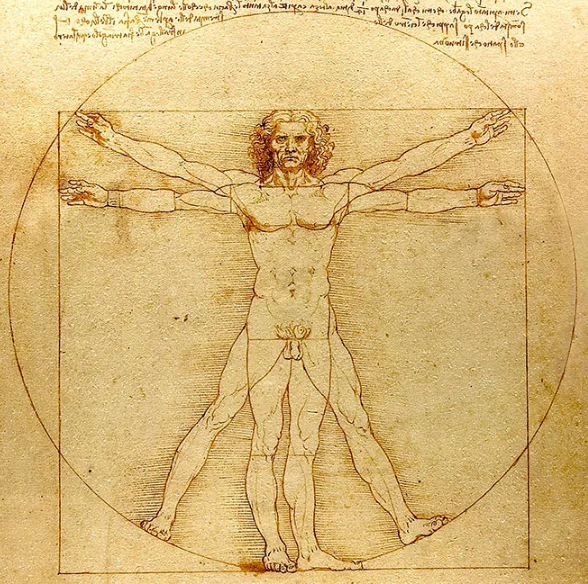Proportional Systems
Joining a cake decorating course will introduce you to crafting icing flowers, where you’ll learn that flowers, depending on their size, typically require groupings of [latex]5[/latex], [latex]8[/latex], or [latex]13[/latex] petals for a realistic look.
If learning to draw portraits, you may be surprised to learn that eyes are approximately halfway between the top of a person’s head and their chin.
Studying architecture, we find examples of buildings that contain golden rectangles and ratios that add to the beautifying of the design. The Parthenon (seen below), which was built around 400 BC, as well as modern-day structures such the Washington Monument are two examples containing these relationships.

These seemingly unrelated examples and many more highlight mathematical relationships that we associate with beauty in artistic form. These include the “Rule of Thirds” and ” the “Golden Ratio”.
Golden Ratio
The golden ratio, also known as the golden proportion or the divine proportion, is a ratio aspect that can be found in beauty from nature to human anatomy as well as in golden rectangles that are commonly found in building structures.
The golden ratio is expressed in nature from plants to creatures such as starfish, honeybees, seashells, and more. It is commonly noted by the Greek letter [latex]\phi[/latex], pronounced “fee”.
[latex]\phi=\frac{1+\sqrt{5}}{2}[/latex], which has a decimal value approximately equal to [latex]1.618[/latex].
golden ratio
Often represented by the Greek letter Phi ([latex]\phi[/latex]), the Golden Ratio (approximately [latex]1:1.618[/latex]) has been used in art and architecture to create aesthetically pleasing proportions.
The golden ratio has been used by artists through the years and can be found in art dating back to 3000 BC. Leonardo da Vinci is considered one of the artists who mastered the mathematics of the golden ratio, which is prevalent in his artwork such as Virtuvian Man (seen below). This famous masterpiece highlights the golden ratio in the proportions of an ideal body shape.

The golden ratio is approximated in several physical measurements of the human body and parts exhibiting the golden ratio are simply called golden. The ratio of a person’s height to the length from their belly button to the floor is [latex]\phi[/latex] or approximately [latex]1.618[/latex]. The bones in our fingers (excluding the thumb), are golden as they form a ratio that approximates [latex]\phi[/latex]. The human face also includes several ratios and those faces that are considered attractive commonly exhibit golden ratios.
The golden ratio ratio is derived from the Fibonacci sequence.
Fibonacci Sequence and Application to Nature
The Fibonacci sequence can be found occurring naturally in a wide array of elements in our environment from the number of petals on a rose flower to the spirals on a pine cone to the spines on a head of lettuce and more.
The Fibonacci sequence can be found in artistic renderings of nature to develop aesthetically pleasing and realistic artistic creations such as in sculptures, paintings, landscape, building design, and more. It is the sequence of numbers beginning with [latex]1[/latex], [latex]1[/latex], and each subsequent term is the sum of the previous two terms in the sequence ([latex]1, 1, 2, 3, 5, 8, 13, …[/latex]).

Fibonacci sequence
The Fibonacci sequence is a series of numbers in which each number is the sum of the two preceding ones. Typically starting with [latex]0[/latex] and [latex]1[/latex], the sequence proceeds as follows: [latex]0, 1, 1, 2, 3, 5, 8, 13,[/latex] and so on.
The petal counts on some flowers are represented in the Fibonacci sequence. A daisy is sometimes associated with plucking petals to answer the question “They love me, they love me not.” Interestingly, a daisy found growing wild typically contains [latex]13[/latex], [latex]21[/latex], or [latex]34[/latex] petals and it is noted that these numbers are part of the Fibonacci sequence. The number of petals aligns with the spirals in the flower family.
Fibonacci sequence
You can view the transcript for “What is the Fibonacci Sequence & the Golden Ratio? Simple Explanation and Examples in Everyday Life” here (opens in new window).
You can view the transcript for “The Fibonacci Sequence: Nature’s Code” here (opens in new window).
You can view the transcript for “The magic of Fibonacci numbers | Arthur Benjamin | TED” here (opens in new window).
Golden Ratio and the Fibonacci Sequence Relationship
Mathematicians for years have explored patterns and applications to the world around us and continue to do so today. One such pattern can be found in ratios of two adjacent terms of the Fibonacci sequence. When computing the ratio of the larger number to the preceding number such as [latex]\frac{8}{5}[/latex] or [latex]\frac{13}{8}[/latex], it is fascinating to find the golden ratio emerge. As larger numbers from the Fibonacci sequence are utilized in the ratio, the value more closely approaches [latex]\phi[/latex], the golden ratio.
Golden Rectangles
Turning our attention to man-made elements, the golden ratio can be found in architecture and artwork dating back to the ancient pyramids in Egypt to modern-day buildings such as the UN headquarters.

The ancient Greeks used golden rectangles — any rectangles where the ratio of the length to the width is the golden ratio — to create aesthetically pleasing as well as solid structures, with examples of the golden rectangle often being used multiple times in the same building such as the Parthenon. Golden rectangles can be found in twentieth-century buildings as well, such as the Washington Monument.
golden rectangle
A golden rectangle is a rectangle in which the ratio of the length to the width is the golden ratio, approximately [latex]1.618[/latex]. If you have a rectangle where the longer side (length) is [latex]a[/latex] and the shorter side (width) is [latex]b[/latex], it will be a Golden Rectangle when the ratio [latex]a/b[/latex] is equal to [latex](a+b)/a[/latex], which equals the golden ratio.
One fascinating property of a Golden Rectangle is that if you remove a square from the rectangle (a square whose sides are equal to the shortest length of the rectangle), the rectangle that’s left over will also be a Golden Rectangle. This property leads to the creation of a logarithmic spiral, which can be drawn within the rectangle by connecting points within the subdivided squares. This spiral is often found in nature, for example, in the arrangement of seeds in sunflowers and the shape of certain galaxies.